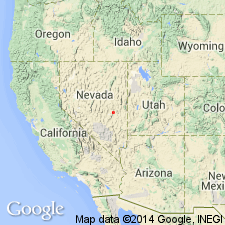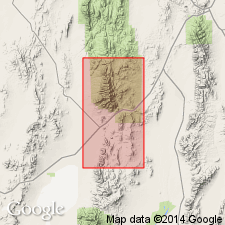
- Usage in publication:
-
- Blind Spring Formation
- Modifications:
-
- Original reference
- Dominant lithology:
-
- Volcaniclastics
- AAPG geologic province:
-
- Great Basin province
Summary:
Pg. 275 (fig. 2). Blind Spring Formation. Listed in generalized stratigraphic chart of Cenozoic section of Grant Range, Nye County, Nevada. Consists of lacustrine and fluvial rocks. Thickness is 0 to 700 feet. Age is Oligocene based on stratigraphic relation with underlying Railroad Rhyolite with isotopic age of 36 Ma.
Oligocene units are (ascending): Railroad Valley Rhyolite, Blind Spring Formation (new), Calloway Well Formation, Saddle Mountain Andesite (new), Stone Cabin Formation, local andesite flows, Currant Tuff, Windous Butte Formation, Forest Home Ignimbrite (new), Needles Range Formation, and Shingle Pass Formation.
Source: US geologic names lexicon (USGS Bull. 1350, p. 77); GNU records (USGS DDS-6; Menlo GNULEX).

- Usage in publication:
-
- Blind Spring Formation
- Modifications:
-
- Age modified
- AAPG geologic province:
-
- Great Basin province
Summary:
Consists of lower red fluvial conglomerate and sandstone derived from rhyolite dome near Currant and upper discontinuous unit of light-green, lacustrine sedimentary deposits. Age is early Oligocene based on K-Ar ages of 33.3 Ma for underlying Railroad Valley Rhyolite and overlying Callowell Well Formation (isotopic ages by R.L. Armstrong).
Source: GNU records (USGS DDS-6; Menlo GNULEX).
For more information, please contact Nancy Stamm, Geologic Names Committee Secretary.
Asterisk (*) indicates published by U.S. Geological Survey authors.
"No current usage" (†) implies that a name has been abandoned or has fallen into disuse. Former usage and, if known, replacement name given in parentheses ( ).
Slash (/) indicates name conflicts with nomenclatural guidelines (CSN, 1933; ACSN, 1961, 1970; NACSN, 1983, 2005, 2021). May be explained within brackets ([ ]).

